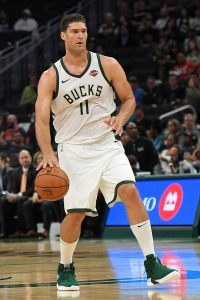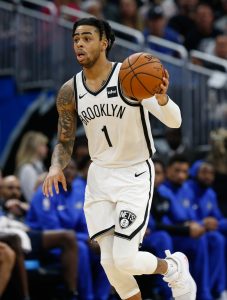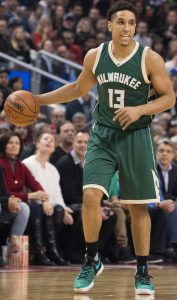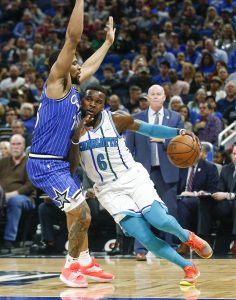Players eligible for restricted free agency don’t become restricted free agents by default. In order to make a player a restricted free agent, a team must extend a qualifying offer to him — a player who doesn’t receive one becomes an unrestricted free agent instead.
The qualifying offer, which is essentially just a one-year contract offer, varies in amount depending on a player’s service time and previous contract status.
If a player reaches free agency with three or fewer years of NBA service time under his belt, his qualifying offer is worth 125% of his prior salary, or his minimum salary plus $200K, whichever is greater. For instance, after earning $1,378,242 this season, Jordan Bell will be eligible for a qualifying offer worth a projected $1,818,486 this offseason — that’s calculated by adding $200,000 to his projected minimum salary for 2019/20 ($1,618,486). Tomas Satoransky‘s 2018/19 salary, on the other hand, was $3,129,187, so his qualifying offer will be worth 125% of that figure: $3,911,484
The qualifying offer for a former first-round pick coming off his rookie scale contract is determined by his draft position. The qualifying offer for a first overall pick is 130% of his fourth-year salary, while for a 30th overall pick it’s 150% of his previous salary — QOs for the rest of the first-rounders fall somewhere in between. The full first-round scale for the draft class of 2015, whose first-rounders will be hitting free agency this summer, can be found here, courtesy of RealGM.
Here are a pair of examples for this offseason, based on RealGM’s chart: 2015’s second overall pick D’Angelo Russell, coming off a fourth-year salary of $7,019,698, must be extended a qualifying offer of $9,160,706 (a 30.5% increase) to become a restricted free agent. Meanwhile, 20th overall pick Delon Wright will be eligible for a qualifying offer of $3,635,375, a 43.3% increase on this season’s $2,536,898 salary.
A wrinkle in the Collective Bargaining Agreement complicates matters for some RFAs-to-be, since a player’s previous usage can impact the amount of his qualifying offer. Certain players who meet – or fail to meet – the “starter criteria,” which we break down in a separate glossary entry, become eligible for higher or lower qualifying offers. Here’s how the starter criteria affects QOs:
- A top-14 pick who does not meet the starter criteria will receive a same qualifying offer equal to 120% of the amount applicable to the 15th overall pick.
- Note: For the summer of 2019, the value of this QO will be $4,485,665. Kristaps Porzingis is one example of a player who falls into this group.
- A player picked between 10th and 30th who meets the starter criteria will receive a qualifying offer equal to 120% of the amount applicable to the ninth overall pick.
- Note: For the summer of 2019, the value of this QO will be $4,915,726. Kelly Oubre is one example of a player who falls into this group.
- A second-round pick or undrafted player who meets the criteria will receive a qualifying offer equal to 100% of the amount applicable to the 21st overall pick.
- Note: For the summer of 2019, the value of this QO will be $3,021,354. Thomas Bryant is one example of a player who falls into this group.
A qualifying offer is designed to give a player’s team the right of first refusal. Because the qualifying offer acts as the first formal contract offer a free agent receives, his team then receives the option to match any offer sheet the player signs with another club.
A player can also accept his qualifying offer, if he so chooses. He then plays the following season on a one-year contract worth the amount of the QO, and becomes an unrestricted free agent at season’s end if he has at least four years of NBA experience. A player can go this route if he wants to hit unrestricted free agency as early as possible, or if he feels like the QO is the best offer he’ll receive. Accepting the qualifying offer also gives a player the right to veto trades for the season.
During the 2018 offseason, for instance, Rodney Hood signed his qualifying offer after failing to secure a longer-term deal with the Cavaliers. When Cleveland agreed to send him to the Trail Blazers prior to the trade deadline, Hood had to give his consent to be dealt, which he did.
Finally, while the details outlined above apply to players on standard NBA contracts who are eligible for restricted free agency, a different set of rules applies to players coming off two-way contracts. For most of those players, the qualifying offer would be equivalent to a one-year, two-way salary, with $50K guaranteed.
If a player coming off a two-way contract is ineligible to sign another one – either because he has already been on two-way deals with his current team for two seasons or because he has four years of NBA service – his qualifying offer would be a standard, minimum-salary NBA contract. The guarantee on that QO would have to match or exceed what a two-way player would earn in the G League.
Note: This is a Hoops Rumors Glossary entry. Our glossary posts will explain specific rules relating to trades, free agency, or other aspects of the NBA’s Collective Bargaining Agreement. Larry Coon’s Salary Cap FAQ and salary information from Basketball Insiders was used in the creation of this post.
Earlier versions of this post were published in previous years. Photo courtesy of USA Today Sports Images.


 After nearly three years away from the NBA,
After nearly three years away from the NBA,  Shelvin Mack
Shelvin Mack